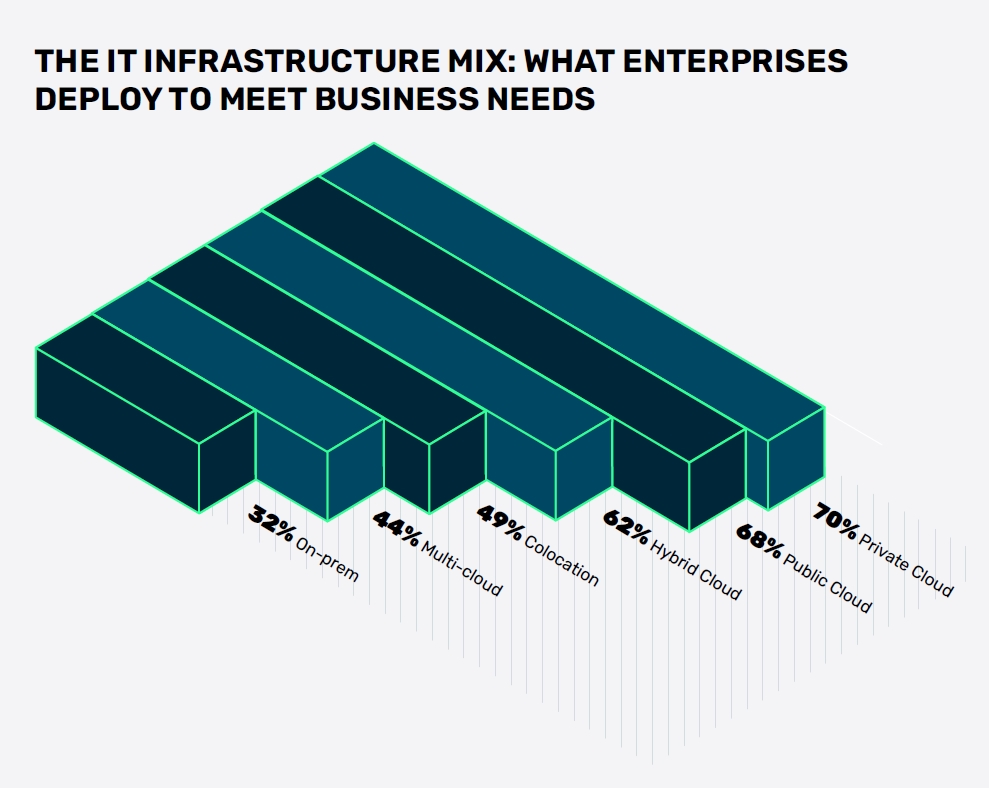
Optimizing Workloads for IT Modernization
“The mix is getting mixier,” said IDG Analyst John Gallant about five minutes into a webinar on hybrid IT trends identified in the 2021 State of the Data Center Report. That caught my attention because I think it’s a clever remark, and because it succinctly characterizes the increasing diversity seen in modern infrastructure.

Our customers tell us that the greatest challenge that comes with “mixier-ness” is determining where to deploy workloads. Furthermore, it’s anything but one-and-done. As business objectives change, processes morph and the “next normal” (for example hybrid work) arrives, each enterprise needs to be able to move/add/turn on and off applications in response. That optionality, agility and control are critical to a “future-proof” infrastructure.
I discuss how colocation and multi-cloud strategies can enable meeting these objectives in our latest white paper, “Solving IT Modernization Challenges with Hybrid IT.” As one key message in the paper, workload repatriation has become a hot topic in response to increasing cloud costs. The primary goals are to reduce total cost of operations, set predictable operational costs, achieve higher levels of security and enhance the customer experience. That’s not to say public cloud adoption is declining. As noted in How Enterprises Solve Wicked IT Problems, “19 percent of enterprises have accelerated public cloud migration, while just two percent moved away from public clouds” in the past two years.¹
Assessing Current IT Infrastructure
So, where do you start optimizing workload deployment? Here are three areas of evaluation and recommendations to consider. Obviously, there are many more factors to weigh when making what are truly critical decisions, and we would welcome the opportunity to discuss them in the context of colocation and the expertise our ecosystem of hybrid IT partners provide.
- Cost – Reducing data egress fees is one reason businesses move applications from a public cloud back on-premises. However, colocating apps in a data center might prove even more cost-effective. Here’s why. Odds are about 50/50 that you are reading this from a remote work location. As enterprises adapt to hybrid work models, they are also adapting their physical workspaces, which can include reducing their on-prem data center footprint. Colocation offers on-premises control, as well as compute, storage and private-network data sharing, without investing in data center expansion, which is inevitable as data volume continues to explode and digital transformation progresses.
- Security – The degree of sensitivity for data is obviously the biggest determinant of where it should “live” in regard to data security. Colocation establishes a position in which an enterprise has excellent infrastructure visibility (including data in motion and at rest) and disaster recovery/business continuity resilience. Each enterprise can determine where data are housed based on their industry and risk tolerance. In CloudCheckr’s 2021 Cloud Infrastructure Report, 44 percent of 300+ IT and business personnel surveyed said that security was the top concern when considering a total cloud migration. That’s just one data point and, as a steward of the industry, it’s important to note that all infrastructure has vulnerabilities.
- Performance – The user experience is a critical measure of success when evaluating application location. Are you getting a consistent experience, regardless of whether the user is accessing the service deployed in a private cloud or at the edge? How much bandwidth is consumed and is the networking cost returning a positive return on investment? Your evaluation might need to include machine-to-machine communications (IoT and perhaps 5G use cases), where near real-time data exchange is essential. On the other hand, for many enterprises, even streaming services, higher levels of latency can be acceptable, and applications are written to anticipate network latency issues. Working with you, our Solution Architects can think through these and other performance benchmarks, with a focus on business objectives.
For enterprises to leverage technology to the best of its possibilities, it’s not just about looking at where hardware or software sits, it’s about how they manage the collective IT infrastructure as an integrated set of resources. It’s about establishing the most effective way to do that from a performance, cost and security perspective, and layering in stacks of various IT resources where they need to be.
Positioning Infrastructure for Tomorrow
How do you build a future-proof infrastructure, one that meets your business objectives today and enables you to take advantage of containerized development to relatively easily lift and redeploy workloads? Colocation can be the foundation for a hybrid IT strategy taking you into the future, enabling workload management at the intersection of the dynamic, interconnecting elements forming your infrastructure – including public and private clouds, hardware and networks.
CoreSite, along with our ecosystem of customers, service providers and partners, can help you develop a custom solution that optimizes your application mix today, with an eye to the future. Because, as we all know, the mix today will probably need to be “mixier” in the near future.
Please download and read Solving IT Modernization Challenges with Hybrid IT, and get it touch with us to discuss your challenges and how we can help.








